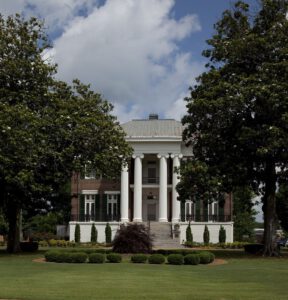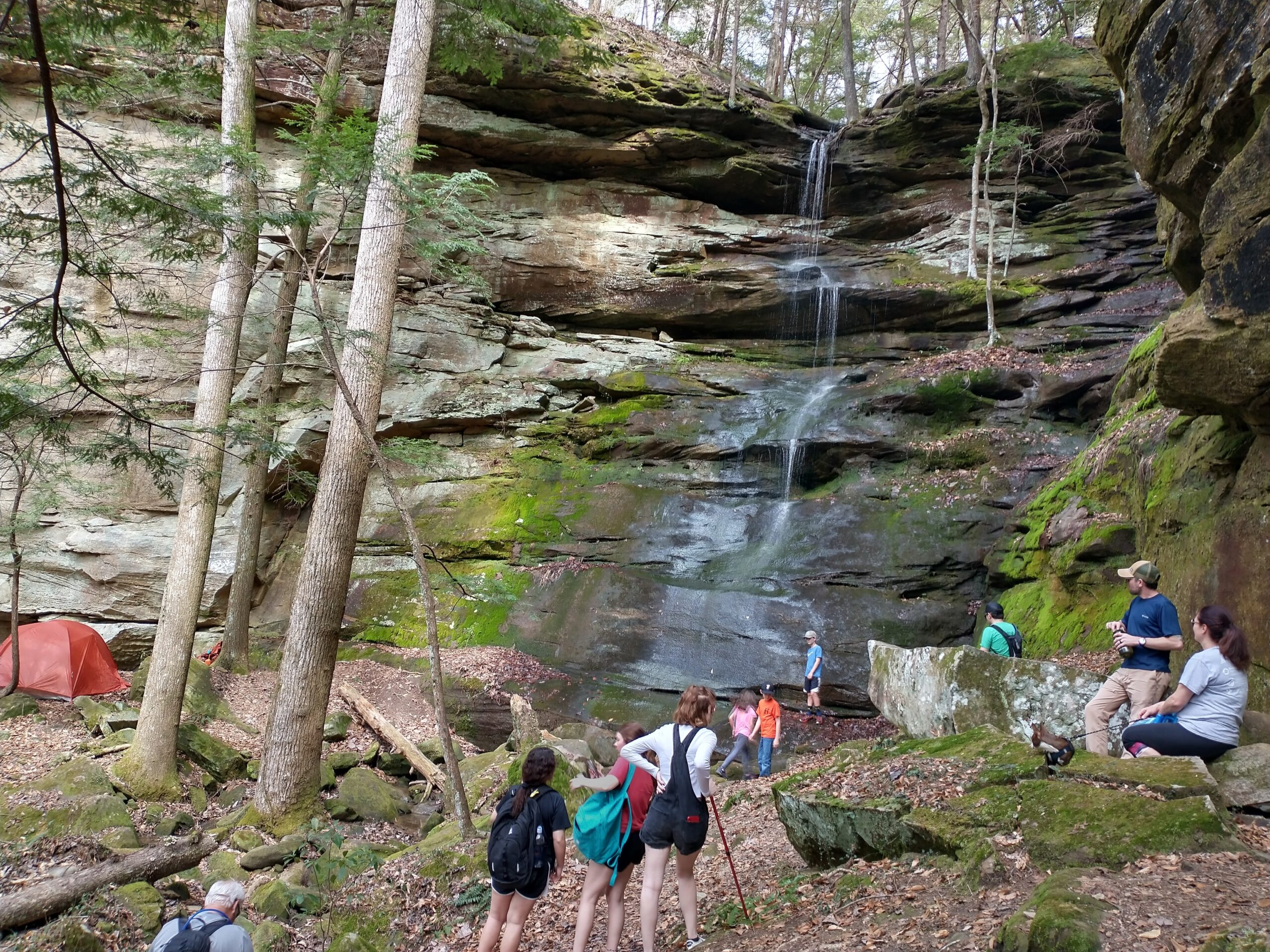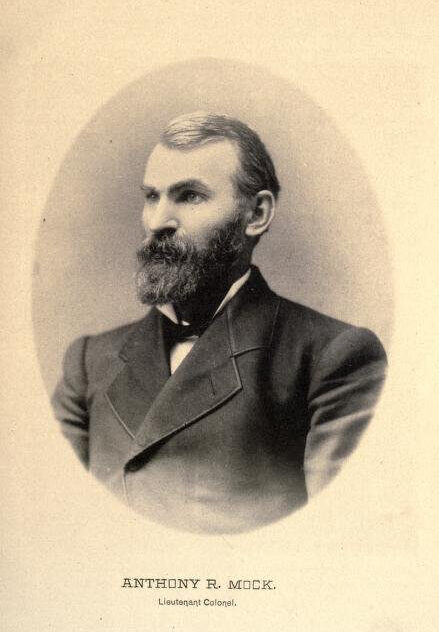By Billy Ray Warren
Florence City Historian
According to tourism professionals, more and more people, it seems, enjoy historic walking tours. There are others, though, who, for various reasons – primarily physical limitations – cannot participate in actual tours. So, come with me on a brief armchair tour of old Florence:
1. We gather on the front lawn of Courtview/Rogers Hall at the northernmost tip of Court Street in downtown Florence. George Washington  Foster was a wealthy planter from Georgia. (It was not uncommon in the early days of our republic for parents to name their children “George Washington” or “Thomas Jefferson” or “Benjamin Franklin.”) Foster and his lovely wife, Sarah Independence Watkins Foster (you gotta love her name!), decided to move to Florence. They wanted to build a mansion, but Court Street was designed by Florence’s planners to be a through-street instead of a cul-de-sac. So, Mr. Foster had to appear before the state legislature to stop Court Street in its tracks. He was granted permission to build the stately home in 1855, with the stipulation that it be worthy of re-routing the street. Of course, most would agree that he fulfilled the stipulation with this magnificent Greek Revival mansion.
Foster was a wealthy planter from Georgia. (It was not uncommon in the early days of our republic for parents to name their children “George Washington” or “Thomas Jefferson” or “Benjamin Franklin.”) Foster and his lovely wife, Sarah Independence Watkins Foster (you gotta love her name!), decided to move to Florence. They wanted to build a mansion, but Court Street was designed by Florence’s planners to be a through-street instead of a cul-de-sac. So, Mr. Foster had to appear before the state legislature to stop Court Street in its tracks. He was granted permission to build the stately home in 1855, with the stipulation that it be worthy of re-routing the street. Of course, most would agree that he fulfilled the stipulation with this magnificent Greek Revival mansion.
Other notables who have owned and occupied this fine home are Gov. Emmet O’Neal and his family and the T.M. Rogers family, owners of the legendary Rogers Department Store a few blocks south of this house on Court Street.
Today, it is owned by the University of North Alabama and serves as the official Alumni House.
2. From Courtview/Rogers Hall, we move across Irvine Avenue to Coby Hall at 459 North Court St. Built in 1843 by John Simpson, it replaced  an older house that was destroyed by fire. Simpson came to Florence as a personal agent for James Jackson, builder of the Forks of Cypress mansion & plantation just outside Florence and nationally recognized as one of the founders of horse racing in America.
an older house that was destroyed by fire. Simpson came to Florence as a personal agent for James Jackson, builder of the Forks of Cypress mansion & plantation just outside Florence and nationally recognized as one of the founders of horse racing in America.
This grand house eventually became the home of Virginia (Foster) and James B. Irvine Jr. Virginia was a daughter of the Fosters who built Courtview/Rogers Hall, and James was the son of Mr. and Mrs. James B. Irvine Sr. who, in 1832, built & occupied the elegant “Hickory Place” mansion at 461 North Pine St. Both Irvine men – Senior and Junior – were early mayors of Florence.
When Virginia and James Jr. married, her parents gave them the mansion known as Mapleton on South Pine Street. The newlyweds lived there a short time, but Virginia didn’t like it. She said the beautiful home was “too far out of town” and, besides, it was haunted (according to her). So, her parents bought them the Simpson house on North Court Street – conveniently located just a few steps away from the homes of both the Fosters and the elder Irvines.
Some years ago, David Brubaker purchased the house and presented it to UNA with the caveat that it be renamed Coby Hall in honor of his late wife and Florence native, Coby (Stockard) Brubaker.
3. Now, we cross Court Street to the Governor O’Neal home at 468 North Court. Not nearly as grand as Courtview/Rogers Hall or Coby Hall, this smaller house has fascinating architectural details, beginning with its handsome front door which features a fan light above it & sidelights flanking it. The wooden columns supporting the front porch are fluted, adding style to the welcoming entryway.
smaller house has fascinating architectural details, beginning with its handsome front door which features a fan light above it & sidelights flanking it. The wooden columns supporting the front porch are fluted, adding style to the welcoming entryway.
Olivia & Edward A. O’Neal and their children owned and occupied this house for many years. O’Neal practiced law in Florence and served as the city’s mayor in the 1850s. He was an officer in the Confederate Army and, later, was elected governor of Alabama. He and Emmet were the first father-son governors of our great atate.
While Edward was away from home during the Civil War, Olivia was left in their house with her young children. Letters which she wrote her husband express her terror at times. (There was never a major battle in Florence, but there were numerous skirmishes.) In one of her letters, she tells her husband that she has asked the Irvines across the street if she and the children might stay in their basement until a particular skirmish ends.
In a true “life-comes-full-circle” story, a direct descendant of Mr. and Mrs. O’Neal now owns the house after it was owned by various other people through the years.
4. A final stop for this armchair tour is Wakefield, located at 450 North Court. Its name derives from its believed similarity to the ancestral home of George Washington in Virginia. On page 14 in “George Washington”, the recent biography by Willard Sterne Randall, the author refers to this local house as a likely near-replica of the original Wakefield.
Built in 1825 by James Sample, a businessman and skilled brick mason who moved to Florence from Georgia, this house is believed to be the first brick house constructed in Florence. Sample owned a store on the Military Road (now Hermitage Drive) near Pope’s Tavern, and he operated a brick yard located near where the lion habitat on UNA’s campus sits today. From the brick yard, he and his workers built Wakefield and other structures in downtown Florence. Sample married Parthenia McVay, a daughter of Hugh McVay of the Mars Hill community who was elected to the state legislature & served briefly as the governor of Alabama. When Parthenia died young, James Sample married her sister, Susan McVay. During the Civil War, Wakefield was owned and occupied by Reverend and Mrs. W.H. Mitchell and their children. As pastor of the storied First Presbyterian Church in downtown Florence, Mitchell was praying for the welfare of Confederate troops from his pulpit on a certain Sunday morning. It happened that some Union troops were in the assembly. They marched to the pulpit, arrested Mitchell and placed him in a federal prison. Though his imprisonment lasted just a few months, it left his wife and children alone in their home – just as Olivia O’Neal and her children suffered the same plight in their home a few houses up the street.
 Well, the armchair tour ends here. In real life it continues a bit and ends in the back yard of Pope’s Tavern so those on the tour might enjoy the restored wagon from the famous Florence Wagon Works (which, in its day, was second only to the Studebaker Company in terms of production and sales) and the two houses at 517 and 521 North Seminary St., which were purchased in the early 1920s via a Sears-Roebuck catalogue – and that, as they say, is another story…
Well, the armchair tour ends here. In real life it continues a bit and ends in the back yard of Pope’s Tavern so those on the tour might enjoy the restored wagon from the famous Florence Wagon Works (which, in its day, was second only to the Studebaker Company in terms of production and sales) and the two houses at 517 and 521 North Seminary St., which were purchased in the early 1920s via a Sears-Roebuck catalogue – and that, as they say, is another story…
Billy Ray Warren, a Florence native, loves his city and was one of the Renaissance Faire founders in 1987. He taught high school history and English in Florence city schools and retired as curriculum director. In 2016, he was appointed city historian.








2 Responses
I think Wakefield was later owned by Dan Glenn if I have my address correct. I worked for him in the 80’s. I was always told by Mrs. Billie Glenn (Dan’s wife) that there was a ghost that haunted the upstairs of their home name Parthenia. I have to say, the upstairs was a might creepy.
Alison — Thanks so much for adding your memories to this story. We’ve all heard much about Parthenia!